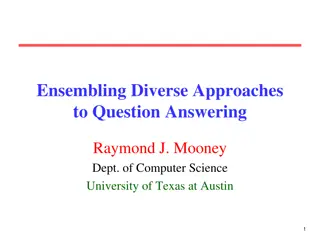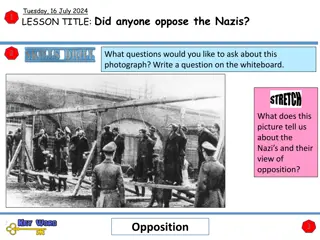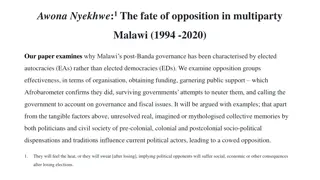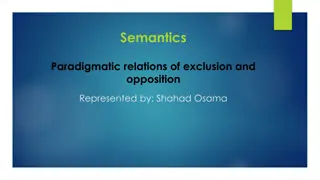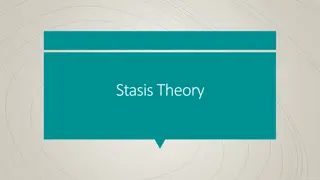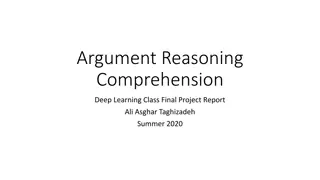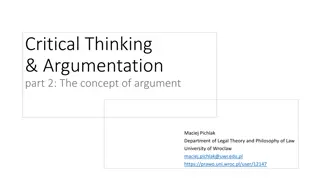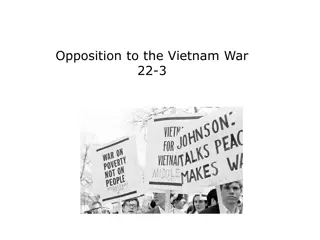Strategies for Answering Opposition in Argumentation
Utilize various strategies to effectively counter opposing viewpoints in arguments, including analogy, classification, comparison/contrast, definition, description, example, humor, narration, problem/solution, and reiteration. Analyze model arguments by summarizing claims, evaluating supporting points, assessing the use of logos, ethos, and pathos, and identifying strategies used. Anticipate and refute common opposing ideas to strengthen persuasive writing.
- Argumentation strategies
- Counter opposition
- Model arguments analysis
- Persuasive writing
- Refuting ideas
Download Presentation

Please find below an Image/Link to download the presentation.
The content on the website is provided AS IS for your information and personal use only. It may not be sold, licensed, or shared on other websites without obtaining consent from the author. Download presentation by click this link. If you encounter any issues during the download, it is possible that the publisher has removed the file from their server.
E N D
Presentation Transcript
Strategies for Argument Answering the Opposition
Using Different Strategies for Argument The strategies for arguing on p. 305-324 of Everyone s an Author are all different ways to support or explain your claim. Not every essay should use every strategy in the chapter, but every essay should use some of them.
Review of Strategy Types Analogy p. 305(make sure that the analogy isn t a false analogy a logical fallacy on p. 297) Classification p. 307 useful if you need to divide a large group into smaller sub-groups. Comparison/Contrast p. 308 Definition p. 311 use if your audience may not be familiar with terms, or if you are using very specific definitions of common terms. Description p. 313 use to create dominant impression, put readers in the scene Example p. 315 make complicated ideas real, back up claim with real-world people the issue affects. (make sure not to make any hasty generalizations from p. 297)
Review of Strategy Types Humor p. 317 make sure that context/audience is appropriate Narration p. 319 similar to example. Tell a story that makes the issue real, presents a problem, opens up an issue for debate. Don t, however, only use narration to make your point. Problem/Solution p. 321 Present your issue as a problem to be solved. Make your audience see why it s a problem. Reiteration p. 322 A little bit of repetition can make your argument much more compelling. Just know why you are repeating certain key concepts/phrases, and ask peers/instructors if repetition is working for you or against you. Which of these strategies do you see your sources using? Which strategies can YOU use as you begin to shape your argument and draft your essay?
Analyzing Model Arguments If you did not bring a source, you must use Our Schools Must Do Better on p. 89 or On Buying Local on p. 92. 1. What is at stake in each of these essays? (See p. 279 in EaA) 2. Summarize the claim the essay is making in your own words and identify where the claim is in the essay by quoting it and giving it credit. 3. Summarize the author s major points of support for the thesis (each essay has at least two, maybe more). Were you convinced by these points? 4. Discuss the essay s use of logos, ethos, and pathos. Identify a place where the author used at least two of these different strategies, and tell me why you think this was a use of logos/ethos/pathos. Do you think the balance of logos, ethos, and pathos was effective and convincing? 5. Which strategies from p. 305-324 does your source use to support the various claims it makes? (There might be more than one.)
Answering the Oppposition No argument occurs in a vacuum. Everyone comes to most topics with some already formed opinions or ideas in the back of their minds. Your job as a persuasive writer is to anticipate the most common of those ideas and to refute them. Refute: to prove false or erroneous (mistaken). Prove a person to be in error. As you do your research, you will encounter ideas on both sides of your argument. Keep track of BOTH SIDES so that when you pick a side, you will already know what the most common arguments for the other side are.
Example of an Answer to the Opposition: Here is an example, summarized from a book by Kim Chernin about women and the pressure to be thin. Chernin s claim: The pressure to be thin is harmful to women. The naysayer/opposition s argument: Some say that losing weight helps a woman feel better about herself and have more confidence, so this pressure to be thin is actually helpful, not harmful. Chernin s answer to the opposition: This boost in confidence is only temporary. A vast percentage of women who lose weight gain it back and then some, making the gain in self-confidence temporary and putting women in a worse position than they were in to begin with. Therefore, the pressure to be thin is still harmful. By including a naysayer (an opposing view) in her argument, Chernin strengthens her original stance.
Example of an Answer to the Opposition: Here is an example from p. 76-77 of Everyone s an Author from an essay written by Jennifer Delahunty, a college admissions officer. Delahunty s claim: College admissions officers take their job seriously and consider each candidate carefully. The naysayer/opposition s argument: Some say that college admissions officers are cavalier (too offhanded or dismissive) about students applications because there are so many applicants. Delahunty s answer to the opposition: She tells a story about how much time the admissions officers spent looking at applications (twelve hours a day), and she tells an even more specific story about one student about whom the admissions offices had a debate before admitting her. Throughout the story, Delahunty shows sympathy and admiration for the applicants, which refutes the opposition s claim that admissions officers are cavalier. By including a naysayer (an opposing view) in her argument, Delahunty strengthens her original stance.
When Answering an Opposing Argument Be fair. Summarize the opposing argument in a way that someone who holds it would recognize and agree with. Avoid making unkind judgments about the people who hold the opposing opinion. Make sure that your answer (refutation) of the opposing argument is strong and relevant. (Don t just dismiss the opposing argument with that doesn t matter.)
Answering the Opposition Remember, the purpose of planting a Naysayer in your essay is to show that you are aware of the other side s argument, aware that not everyone is going to agree with you immediately, and that you have an answer for those arguments or objections. This means that you need to make sure that your argument is stronger for having included the naysayer because you have answered the opposition.
Answering the Opposition Practice Identify a claim that a source, or a person interviewed in a source, makes that you disagree with for good reasons. Write a paragraph where you: 1. Set up the debate. Give the audience the context they need to understand your claim, the opposition, and your response. 2. Make YOUR claim. 3. Summarize/quote the claim from your opposition, giving credit in MLA format and identifying it as the opposition. 4. Answer the opposition s claim with your good reasons for disagreement.
Context and Claim: For many years, various sports teams have used images of Native Americans as mascots. There is growing opposition to the use of these mascots, with Native American activists arguing that the mascots are both offensive and stereotypical. The owners of these sports teams with Native American mascots should listen carefully to the people whose images they are making money off of, and if the mascot is offensive, it should be retired.
Summary of Opposition Some people who oppose the change and believe that teams should keep their mascots worry that to change the mascots would set a precedent that would allow any group that was offended by a mascot for any frivolous reason to demand a change. According to Dave Zirin, a common version of this argument is, Changing the name of the Redskins and the Seminoles...where does the politically correct madness end? Do we stop using 'Giants' because it offends tall people? Or 'Cowboys' because it offends cowboys? "
Answer to the Opposition This argument may sound convincing, but it contains a logical fallacy. It is an argument by false analogy. To compare tall people, or cowboys, who are not discriminated against in any measurable way to Native Americans who have been systematically oppressed and experienced the erasure of their cultures and their languages is insulting. There are no groups advocating for the rights of tall people, and to seriously suggest that changing Native American mascots would invite these kinds of frivolous demands is a slippery slope argument that dismisses legitimate concerns and avoids recognizing the real problem: the racist stereotypes being perpetuated by the mascots in question.
For many years, various sports teams have used images of Native Americans as mascots. There is growing opposition to the use of these mascots, with Native American activists arguing that the mascots are both offensive and stereotypical. The owners of these sports teams with Native American mascots should listen carefully to the people whose images they are making money off of, and if the mascot is offensive, it should be retired. Some people who oppose the change and believe that teams should keep their mascots worry that to change the mascots would set a precedent that would allow any group that was offended by a mascot for any frivolous reason to demand a change. According to Dave Zirin, a common version of this argument is, Changing the name of the Redskins and the Seminoles...where does the politically correct madness end? Do we stop using 'Giants' because it offends tall people? Or 'Cowboys' because it offends cowboys? This argument may sound convincing, but it contains a logical fallacy. It is an argument by false analogy. To compare tall people, or cowboys, who are not discriminated against in any measurable way to Native Americans who have been systematically oppressed and experienced the erasure of their cultures and their languages is insulting. There are no groups advocating for the rights of tall people, and to seriously suggest that changing Native American mascots would invite these kinds of frivolous demands is a slippery slope argument that dismisses legitimate concerns and avoids recognizing the real problem: the racist stereotypes being perpetuated by the mascots in question.


